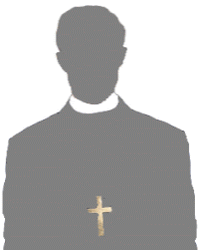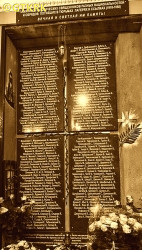Roman Catholic
St Sigismund parish
05-507 Słomczyn
85 Wiślana Str.
Konstancin deanery
Warsaw archdiocese, Poland
full list:
displayClick to display full list

searchClick to search full list by categories
wyświetlKliknij by wyświetlić pełną listę po polsku

szukajKliknij by przeszukać listę wg kategorii po polsku

Martyrology of the clergy — Poland
XX century (1914 – 1989)
personal data

surname
KRZYWICKI
forename(s)
Adolph (pl. Adolf)
function
diocesan priest
creed
Latin (Roman Catholic) Church RCmore on
en.wikipedia.org
[access: 2014.09.21]
diocese / province
Mogilev archdiocesemore on
en.wikipedia.org
[access: 2013.06.23]
Minsk diocesemore on
en.wikipedia.org
[access: 2013.05.19]
date and place
of death
09.11.1942

ITL UkhtIzhemLagGuLAG slave labour camp network
today: Vetlasyan‐Ukhta, Komi rep., Russia
details of death
After 1920 and Ryga truce ending Polish–Russian war of 1919‐1920 remained in Russia.
Arrested by the Russians on 05.08.1933 (or 04.11.1933) in Borisov.
Jailed in Minsk prison.
On 24.02.1934, pursuant to Art. 58‐2, 58‐6, 58‐10 and 58‐11 of the Penal Code, sentenced by the genocidal Russian Special Council «GPU Troika» to 10 years of slave labour in Russian concentration camps — Gulag.
02.04.1934 transported, through Kirov, to ITL UkhtPechLag concentration camp.
Next on 15.07.1935 transferred to Ust‐Vym in Komi rep.
n. Arkhangelsk (the seat of later ITL UstVymLag camp).
In 04.1937 transferred back to ITL UkhtPechLag's sub‐camp for invalids.
Later moved again a few times — was seen in the transit camps Potma n. Ukhta (11.1940) and Knyazh–Pohost n. Yemva, part of ITL UkhtIzhemLag concentration camp (12.1941) — created from the split of ITL UkhtPechLag camp.
Finally sent to Vetlasyan village, 2 km from Ukhta, where camp's hospital was located and where perished from pneumonia (angina).
cause of death
extermination
perpetrators
Russians
sites and events
ITL UkhtIzhemLagClick to display the description, ITL UkhtPechLagClick to display the description, ITL UstVymLagClick to display the description, UchtaClick to display the description, GulagClick to display the description, MinskClick to display the description, Polish‐Russian war of 1919‐1921Click to display the description
date and place
of birth
15.05.1887

Khrapenevotoday: Vselyub ssov., Navahrudak dist., Grodno reg., Belarus
more on
be.wikipedia.org
[access: 2023.01.18]
presbyter (holy orders)
ordination
1910

positions held
1923 – 1933
priest — Barysawtoday: Barysaw dist., Minsk reg., Belarus
more on
en.wikipedia.org
[access: 2022.09.11] ⋄ Assumption of the Blessed Virgin Mary RC parish ⋄ Barysawtoday: Barysaw dist., Minsk reg., Belarus
more on
en.wikipedia.org
[access: 2022.09.11] RC deanery
priest — Zembintoday: Zembin ssov., Barysaw dist., Minsk reg., Belarus
more on
en.wikipedia.org
[access: 2022.01.06] ⋄ Assumption of the Blessed Virgin Mary RC parish ⋄ Barysawtoday: Barysaw dist., Minsk reg., Belarus
more on
en.wikipedia.org
[access: 2022.09.11] RC deanery
dean — Kharkivtoday: Kharkiv urban hrom., Kharkiv rai., Kharkiv obl., Ukraine
more on
en.wikipedia.org
[access: 2022.08.05] RC deanery
1915 – c. 1923
curatus/rector/expositus — Sumytoday: Sumy urban hrom., Sumy rai., Sumy obl., Ukraine
more on
en.wikipedia.org
[access: 2022.08.05] ⋄ RC church ⋄ Kharkivtoday: Kharkiv urban hrom., Kharkiv rai., Kharkiv obl., Ukraine
more on
en.wikipedia.org
[access: 2022.08.05], RC parish ⋄ Kharkivtoday: Kharkiv urban hrom., Kharkiv rai., Kharkiv obl., Ukraine
more on
en.wikipedia.org
[access: 2022.08.05] RC deanery
from 1915
prefect — Sumytoday: Sumy urban hrom., Sumy rai., Sumy obl., Ukraine
more on
en.wikipedia.org
[access: 2022.08.05] ⋄ Cadet Corps, Realschule, gymnasium for Boys, 1st and 2nd gymnasium for Girls
1911 – 1915
vicar — Navahrudaktoday: Navahrudak dist., Grodno reg., Belarus
more on
en.wikipedia.org
[access: 2021.07.04] ⋄ St Michael the Archangel RC parish ⋄ Navahrudaktoday: Navahrudak dist., Grodno reg., Belarus
more on
en.wikipedia.org
[access: 2021.07.04] RC deanery
till 1910
student — Sankt Petersburgtoday: Saint Petersburg city, Russia
more on
en.wikipedia.org
[access: 2020.07.31] ⋄ philosophy and theology, Metropolitan Theological Seminary
others related
in death
RUDŽIONISClick to display biography Steven
sites and events
descriptions
ITL UkhtIzhemLag: Russian Rus. Исправи́тельно‐Трудово́й Ла́герь (Eng. Corrective Labor Camp) ITL Rus. Ухто‐Ижемский (Eng. Ukht‐Izhemskiy) — concentration and slave forced labor camp (within the Gulag complex) — headquartered in Ukhta (till 1939 known as Chibyu) in Izhma river region, in Komi Republic. Founded on 10.05.1938, after being carved out of the ITL UkhtPechLag concentration camp. Prisoners slaved at the exploration and extraction of crude oil, installation of drilling towers, construction of gas pipelines, oil processing plants, construction of tanks for crude oil and diesel oil, in building materials factories (e.g. bricks), quarries, logging and wood processing, in paper mills, construction and maintenance (clearing snow) of roads, in mechanical and repair workshops, during loading and unloading work, etc. Among them were many Poles brought in 1939 after the Russian invasion of Poland, Germans (i.e. of German extraction, including women, from the Volga region) and citizens of the Baltic countries (mainly after 1944). At its peak — till the death on 05.03.1953 of Russian socialist leader, Joseph Stalin — c. 40,000 prisoners were held there: e.g. 30,453 (01.07.1938); 27,006 (01.01.1939); 39,087 (01.07.1941); 25,331 (01.01.1942); 24,651 (01.01.1947); 34,072 (01.01.1948); 35,625 (01.01.1949); 37,180 (01.01.1950); 34,546 (01.01.1951); 33,544 (01.01.1952); 30,275 (01.01.1953). Ceased to operate on 18.05.1955 and was incorporated, together with many sub‐camps, into the ITL PechorLag concentration camp. (more on: old.memo.ruClick to attempt to display webpage
[access: 2024.04.08])
ITL UkhtPechLag: Russian Rus. Исправи́тельно‐Трудово́й Ла́герь (Eng. Corrective Labor Camp) ITL Rus. Ухто‐Ижемский (Eng. Ukht‐Izhemskiy) — concentration and slave forced labor camp (within the Gulag complex) — headquartered in Chibyu (today: Ukhta) in Izhma river region, in Komi Republic. Founded on 06.06.1931. Prisoners slaved at the search for and extraction of crude oil and coal, radium, natural gas, asphaltite (high concentration of radium was detected in the camp, the highest in the world in water layers), in the construction of gas plants, access roads (e.g. Chibyu‐Krutaya), railway lines (e.g. Chibyu‐Ust‐Vym‐Kotlas, Vorkuta‐Ust‐Usa‐Kozhva), river barge construction, forest clearing and timber harvesting, etc. At its peak — till the death on 05.03.1953 of Russian socialist leader, Joseph Stalin — c. 5,000 prisoners were held there: e.g. 13,400 (12.1932); 23,840 (01.01.1934); 20,730 (01.01.1935); 21,750 (01.01.1936); 31,035 (01.01.1937); 54,792 (01.01.1938). Ceased to exist on 10.05.1938 when the camp was divided into four camp complexes: ITL UkhtIzhemLag (50,000 km2), ITL VorkutLag, ITL SevZhelDorLag and ITL UstVymLag. (more on: old.memo.ruClick to attempt to display webpage
[access: 2024.04.08])
ITL UstVymLag: Russian Rus. Исправи́тельно‐Трудово́й Ла́герь (Eng. Corrective Labor Camp) ITL Rus. Устьвымский (Eng. UstVymskiy) — concentration and slave forced labor camp (within the Gulag complex) — headquartered in Vozhayol settlement the Veslyana River in the rep. Komi, c. 16 km from the Kotlas‐Vorkuta railway line. Founded on 16.08.1937, from part of ITL UkhtPechLag. Prisoners slaved at the forest felling, processing, floating and delivery of wood to the Pechora coal basin, production of railway sleepers, skis and half‐finished ski products, furniture, construction of warehouses and workshops, pottery and shoe production, mechanical and repair workshops, brick kilns, etc. At its peak — till the death on 05.03.1953 of Russian socialist leader, Joseph Stalin — c. 24,000 prisoners were held there: e.g. 24,183 (01.07.1941); 21,953 (01.01.1942); 24,245 (01.01.1943); 20,703 (01.01.1948); 20,376 (01.01.1949); 19,893 (01.01.1950); 21,862 (01.01.1952); 23,632 (01.01.1953); 19,591 (01.01.1955); 19,993 (01.01.1956); 21,483 (01.01.1957); 20,108 (01.01.1959); 17,901 (01.01.1960). In 1943 most of the prisoners, 14,522 (c. 60%), were convicted of „anti‐revolutionary activities”. There were also 2,104 women among the prisoners (c. 9%). In 1938 the mortality rate was c. 8%.Ceased to exist in 1960. (more on: old.memo.ruClick to attempt to display webpage
[access: 2024.04.08])
Uchta: Local capital of a series of Russian concentration camps and forced labour camps — among others in diamond mines and at oil production — part of GULAG penal system, in the Komi republic (beyond Arctic Circle) — such as Uchpechłag, ITL VorkutLag, Inta, Uchwymlag, ITL UkhtIzhemLag, Sieżeldor forced labour camps. (more on: pl.wikipedia.orgClick to attempt to display webpage
[access: 2013.08.17])
Gulag: The acronym Gulag comes from the Rus. Главное управление исправительно‐трудовых лагерей и колоний (Eng. Main Board of Correctional Labor Camps). The network of Russian concentration camps for slave labor was formally established by the decision of the highest Russian authorities on 27.06.1929. Control was taken over by the OGPU, the predecessor of the genocidal NKVD (from 1934) and the MGB (from 1946). Individual gulags (camps) were often established in remote, sparsely populated areas, where industrial or transport facilities important for the Russian state were built. They were modeled on the first „great construction of communism”, the White Sea‐Baltic Canal (1931‐1932), and Naftali Frenkel, of Jewish origin, is considered the creator of the system of using forced slave labor within the Gulag. He went down in history as the author of the principle „We have to squeeze everything out of the prisoner in the first three months — then nothing is there for us”. He was to be the creator, according to Alexander Solzhenitsyn, of the so‐called „Boiler system”, i.e. the dependence of food rations on working out a certain percentage of the norm. The term ZEK — prisoner — i.e. Rus. заключенный‐каналоармец (Eng. canal soldier) — was coined in the ITL BelBaltLag managed by him, and was adopted to mean a prisoner in Russian slave labor camps. Up to 12 mln prisoners were held in Gulag camps at one time, i.e. c. 5% of Russia's population. In his book „The Gulag Archipelago”, Solzhenitsyn estimated that c. 60 mln people were killed in the Gulag until 1956. Formally dissolved on 20.01.1960. (more on: en.wikipedia.orgClick to attempt to display webpage
[access: 2024.04.08])
Minsk: Russian prison. In 1937 site of mass murders perpetrated by the Russians during a „Great Purge”. After Russian invasion of Poland in 09.1939 and start of the World War II place of incarceration of many Poles, In 06.1941, under attack by Germans, Russians murdered there a group of Polish prisoner kept in Central and co‐called American prisons in Mińsk. The rest were driven towards Chervyen in a „death march” (10,000‐20,000 prisoners perished), into Russia. (more on: pl.wikipedia.orgClick to attempt to display webpage
[access: 2013.08.17])
Polish‐Russian war of 1919‐1921: War for independence of Poland and its borders. Poland regained independence in 1918 but had to fight for its borders with former imperial powers, in particular Russia. Russia planned to incite Bolshevik‐like revolutions in the Western Europe and thus invaded Poland. Russian invaders were defeated in 08.1920 in a battle called Warsaw battle („Vistula river miracle”, one of the 10 most important battles in history, according to some historians). Thanks to this victory Poland recaptured part of the lands lost during partitions of Poland in XVIII century, and Europe was saved from the genocidal Communism. (more on: en.wikipedia.orgClick to attempt to display webpage
[access: 2014.12.20])
sources
personal:
crusader.org.ruClick to attempt to display webpage
[access: 2019.02.02], biographies.library.nd.eduClick to attempt to display webpage
[access: 2014.05.09], cathol.memo.ruClick to attempt to display webpage
[access: 2019.02.02], ru.openlist.wikiClick to attempt to display webpage
[access: 2024.04.08]
bibliographical:
„Fate of the Catholic clergy in USSR 1917‐1939. Martyrology”, Roman Dzwonkowski, SAC, ed. Science Society KUL, 2003, Lublin
original images:
ipn.gov.plClick to attempt to display webpage
[access: 2019.02.02]
LETTER to CUSTODIAN/ADMINISTRATOR
If you have an Email client on your communicator/computer — such as Mozilla Thunderbird, Windows Mail or Microsoft Outlook, described at WikipediaPatrz:
en.wikipedia.org, among others — try the link below, please:
LETTER to CUSTODIAN/ADMINISTRATORClick and try to call your own Email client
If however you do not run such a client or the above link is not active please send an email to the Custodian/Administrator using your account — in your customary email/correspondence engine — at the following address:

giving the following as the subject:
MARTYROLOGY: KRZYWICKI Adolph
To return to the biography press below:
 Click to return to biography
Click to return to biography








